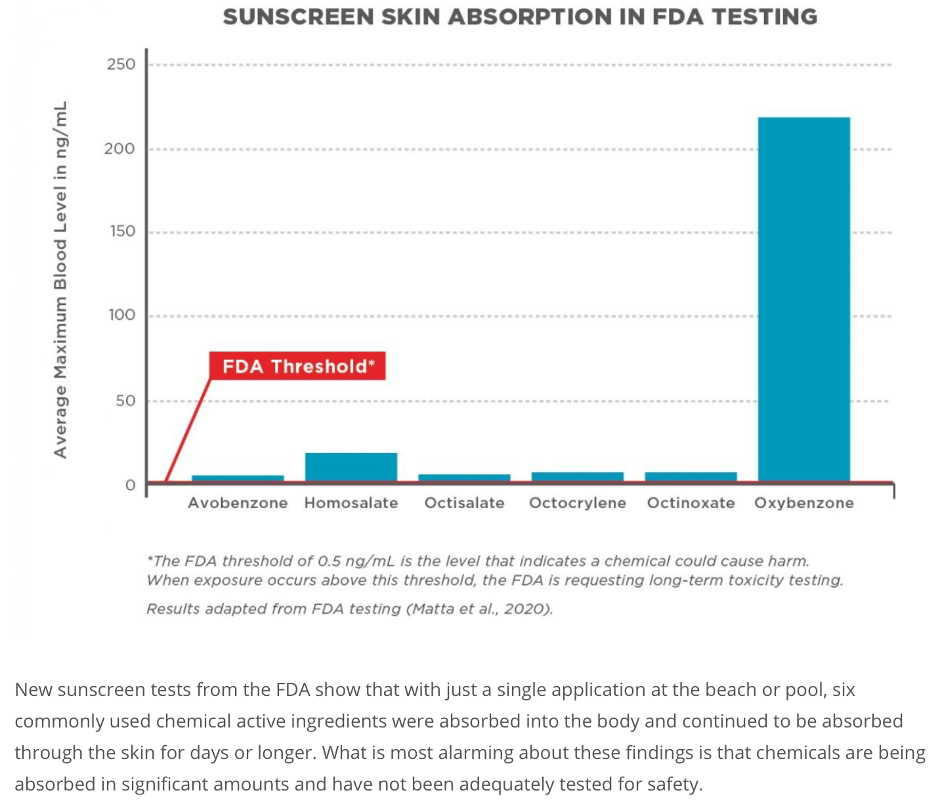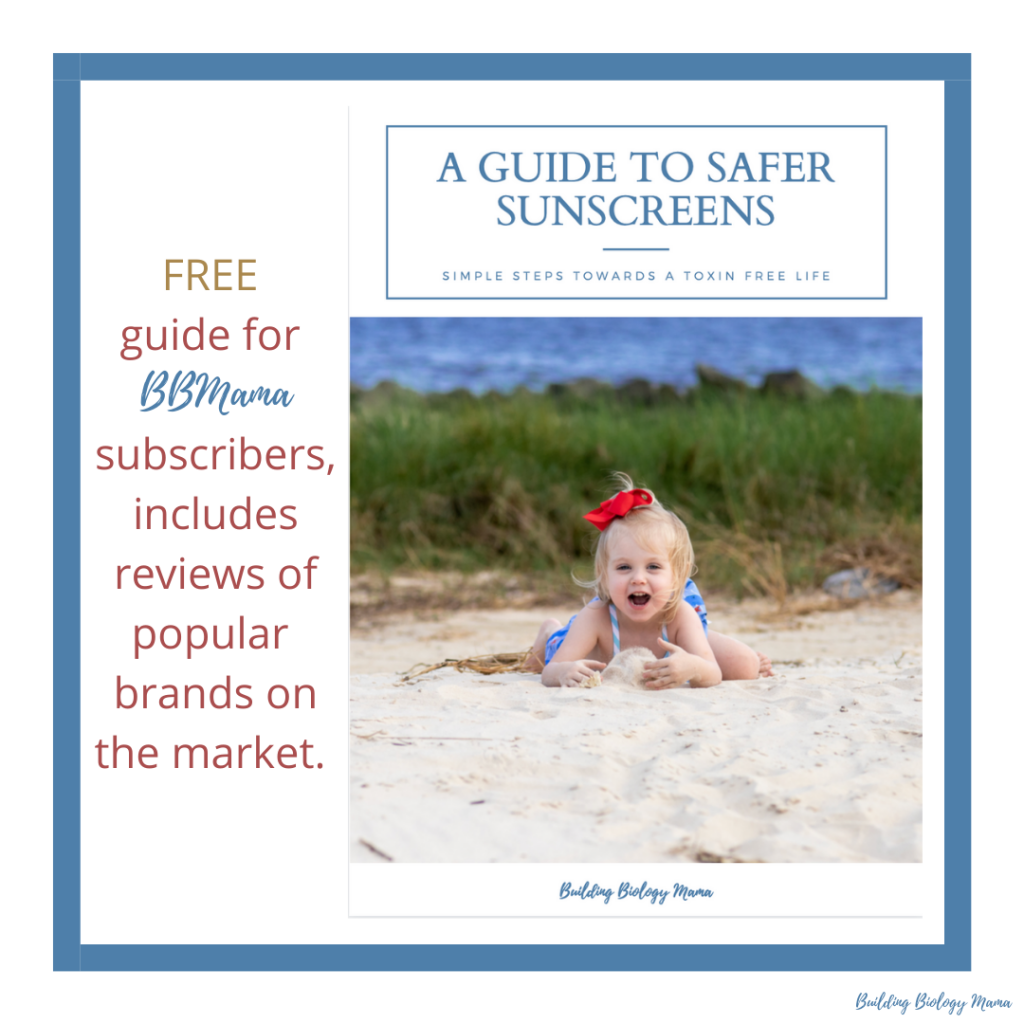With the Australian summer heating up, it is important to have some non-toxic sunscreen on hand.
Whilst my family prefers to cover up over slathering up which I explained last week, there are still moments when we need to reach for the sunscreen. We have a couple of favourites and this post explains what information I weigh up when looking at what to buy.
To make an informed choice when buying any sunscreen, we need to understand a tiny bit of science and what label claims actually mean.
What is SPF and is Higher SPF Better?
On the surface, it may seem the higher the SPF the more protected you are however when you review what SPF actually stands for and means, you realise it isn’t as straight forward as that and you may be lulled into a false sense of security.
SPF refers to the Sun Protection Factor and is an indication of how well a sunscreen can protect your skin from sunburn. In other words, it is generally an indicator or measure of how well it can protect your skin from UVB radiation and not necessarily an indication of protection from other types of skin damage (such as free radical damage or skin aging).
If applied adequately:
- An SPF 15 sunscreen blocks 93% of UVB rays
- An SPF 30 blocks 96.7% of UVB rays
- An SPF 40 blocks 97.5% of UVB radiation
- An SPF 50 blocks 98% of UVB rays
It is not surprising then that clinically, higher SPF values have not shown to be beneficial and EWG recommends that consumers avoid products that claim a SPF higher than 50+.
What is Broad Spectrum Sunscreen and How is it Different from Regular Sunscreen?
There are two different types of sunscreen: regular and broad spectrum.
Since 2012, broad spectrum performance is mandatory for all primary sunscreens in Australia.
As you may have picked up, SPF only refers to UVB and alone it is no indication of how well it provides protection or cover from UVA. Hence the use of the term ‘broad spectrum’.
Broad spectrum sunscreens provide protection from both UVA and UVB rays.
Both types of rays have the potential to cause skin damage, ageing and skin cancers, so it makes sense that you may need protection from both.
How much coverage or effective a broad spectrum sunscreen provides is debatable. The EWG believes sunscreen standards for broad spectrum and UVA are set too low and higher standards for UVA protection is necessary to prevent skin damage and skin cancers effectively.
One thing consumers should be aware of because of the way the standards are set up “The broad spectrum statement and SPF value together provide a measure of both UVB and UVA protection, with increasing SPF values indicating a proportional increase in UVA protection”.
Dermal Exposure- Why NOT ALL Sunscreens are Good Enough for My Family
Sunscreen ingredients soak through skin and can be detected in human blood, urine and even breast milk. The reason being, chemicals that we absorb through our skin enter our blood stream before being metabolized by the liver, making them an important exposure source.
The results of a US FDA-led January 2020 study not only confirmed that some chemical sunscreen ingredients are readily absorbed into our bloodstream after one application, but also that the concentration absorbed exceeded FDA safety guidelines and some ingredients can stay in the blood for at least 3 weeks.”
“So what ingredients are necessary for sunburn protection and what ingredients are not or pose adverse health risks?”
The Active Chemicals to Steer Away From
All chemical sunscreens on the Australian market have to pass TGA approval. But one should be aware that whilst the TGA assesses the ‘safety’ of ingredients used in sunscreen products, they do not assess the product itself, before a product is released onto the market. This means the TGA does not test the complete sunscreen product as a whole.
That said, the Australasian College of Dermatologists says “there is currently no scientific evidence demonstrating long-term side effects including any hormonal effects, following regular use of sunscreen.”
However in conflict of this, there are two sunscreen chemicals in particular that the US EWG have noted due to their high toxicity concerns. The chemicals are oxybenzone and octinoxate with an EWG toxicity rating of 8 and 6 out of 10 respectively. Both of these chemicals are registered for use as chemical ingredients for sunscreens with the Australian TGA.
Further supporting the fact that NOT ALL sunscreen ingredients may be safe, is the fact that the US FDA acknowledges that of the 14 active ingredients approved for use in US sunscreens, the FDA have determined there is INSUFFICIENT SAFETY DATA of 12 of them. Many of these chemicals are registered for use in Australian sunscreens as well!
So there ARE chemicals used in sunscreens that may be detrimental to our health, TGA approved or not.
In particular, I steer away from:
- 4-Methylbenzylidene camphor
- Homosolate
- Menthyl anthranilate
- Octinoxate
- Octisalate
- Octocrylene
- Oxybenzone
- PABA
- Padimate O
- PEG-25 PABA
- Sulisobenzone
- Trolamine salicylate
Inactive Ingredients to Steer Away From
Active ingredients are the ingredients which give a sunscreen its ability to “protect you from UV”. Inactive ingredients are the other ingredients added to the sunscreen that provide moisturisation, scent/fragrance or preservatives etc.
Inactive ingredients can be difficult to assess as most chemical sunscreen manufacturers like: Banana Boat, Cancer Council, Ego Sunsense and some physical barrier sunscreen manufacturers like: Invisible Zinc, do not disclose a full list of ingredients.
Inactive ingredients I prefer to steer away from:
- Fragrances
- Parabens
- PEGs
- Phenoxyethanol
- Phthalates
- Synthetic colours
- Problematic preservatives, including Methylisothiazolinone
- Retinyl palmitate (Vitamin A palmitate)
What about aerosol sunscreens?
Well unfortunately the ingredients specifically in sunscreens haven’t been tested for long term health effects in their aerosolised form. There are also some concerns that the ingredients could potentially cause irreversible lung damage as the chemicals are inadvertently inhaled.
Add to that, the fact that even and effective coverage is more difficult, I don’t personally opt to use spray sunscreens.
The Ingredients I Look For in Non-Toxic Sunscreens
According to the FDA, only two active ingredients have been given GRASE status. GRASE stands for Generally Recognised as Safe and Effective and as it sounds are the ONLY ACTIVE sunscreen INGREDIENTS considered as safe and effective.
The two ingredients are Zinc Oxide and Titanium Dioxide.
Zinc oxide and titanium dioxide are also the only two ingredients recognised by the EWG as posing the lowest hazard of sunscreen ingredients approved by the FDA and TGA.
Zinc Oxide is the active ingredient I look for when weighing up a sunscreen’s suitability. Zinc oxide provides a physical barrier to UVA and UVB. A physical barrier is exactly as it sounds, it provides a physical barrier between your skin and the sun. Picture thick layers of zinc applied over your nose as a child or as seen on the Aussie cricketers during the summer.
Ok so I know your next question, what about nano particles? And is micronised zinc any better? Great questions. Not quick to answer though. Join me next week where we define what nanoparticles and micronized zinc actually are. I review the science, explain the FDA and TGA’s stance on nanoparticles in sunscreen and why you need to be careful of labelling.

A Review of the Brands
There are so many sunscreen brands on the market and sometimes you don’t want to read labels, you just want to know what to buy. Sometimes, you want to know how the half bottle of sunscreen you have left in the bathroom measures up. Is it ok but could be better? Is it toxic? Should you finish it off, or throw it away now?
I have reviewed 59 available sunscreens on the Australian market and have collated it into an easy to download pdf eBook. I am currently giving it away FREE to my email subscribers. If you want a copy of my Guide to Safer Sunscreen, subscribe here and it will be automatically delivered to your inbox. If you are already a subscriber, just send me a quick email at info@buildingbiologymama.com.au and I will email you the eBook.
Whilst my Guide to Safer Sunscreens isn’t exhaustive of ALL the brands on the market, at over 50+ available sunscreens on the market it is a great start. If you have a brand of sunscreen you want reviewed and it isn’t in my guide, email and I will do some research and add it to the list.
What Does My Family Use?
There isn’t just one brand of sunscreen my family reaches for when the need arises, however there is one that we favour most. And that sunscreeen is SunButter’s Water Resistant Reef Safe Sunscreen.
SunButter’s range of sunscreen not only meets my low tox criteria but it is also the most eco conscious and eco friendly sunscreen on the market in my opinion.
SunButter is founded by two dedicated marine biologists who have not just thrown around the “eco” buzz word but rather encompassed what a true ethical eco conscious company should look like.
XxTammy
Please Note: The content & media published on this website is the personal opinions of BBMama and are for informational purposes only. It is not intended to be a substitute for professional medical advice and should not be relied on as health or personal advice.
References
EWG, 2020. The trouble with ingredients in sunscreens (online) available: https://www.ewg.org/sunscreen/report/the-trouble-with-sunscreen-chemicals/ (last accessed January 2021)
FDA, 2019. Sunscreen Drug Products for Over-the- Counter Human Use. Federal register,84 (38), pp.6204-6275. available: https://www.govinfo.gov/content/pkg/FR-2019-02-26/pdf/2019-03019.pdf (last accessed January 2021)
Ngan, V., 2012. Sunscreen testing and classification (online) available: https://www.dermnetnz.org/topics/sunscreen-testing-and-classification/ (last accessed January 2021)
TGA, 2017. Literature review on the safety of titanium dioxide and zinc oxide on nanoparticles in sunscreens. (online) available: https://www.tga.gov.au/sites/default/files/nanoparticles-sunscreens-review-_2016_1.pdf (last accessed January 2021)
TGA, 2019. Australian regulatory guidelines for sunscreens (online) available: https://www.tga.gov.au/book/export/html/5307 (last accessed January 2021)





